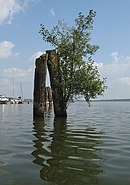Dalbe



Under a Dalbe , Dalle , or a dolphin , Dälben , or Duck -, Duk - or Dückdalben , is understood in the port site rammed piles for fastening or reject vessels or for labeling of the fairway .
Origin of the term
The name goes back to the Duke of Alba (Duc d'Albe), who had such facilities set up in ports of the former Spanish Netherlands to accommodate additional ships in a port. In Spanish these dolphins are called directly "duque de Alba", ie "Duke of Alba". Accordingly, they used to be called Duckdalben in Germany. The name, shortened or changed in similar spellings, can also be found in several European languages; Another version says that it is based on the term »thick thollen«, which is common in Friesland
Layout and function
From a technical point of view, dolphins are piles or groups of piles clamped in the river bed under horizontal load. The river bed is usually the naturally occurring soil, while the horizontal load to be absorbed by the dolphins is usually caused by the impact or cable pull of ships.
Dolphins can be roughly divided into two groups according to their various purposes:
- Mooring albums, guiding dolphins or repelling dolphins: They serve the purpose of mooring, guiding and repelling ships and marking the fairway. In order to avoid damage to ships, these dolphins must be as elastic as possible. The large impact energies that occur are converted by the deformation work of the dolphin and the subsoil.
- Mooring albums: They are used for mooring and mooring . Rigid structures are more suitable here. A pole that is as rigid as possible is also advantageous when casting off.
- Deviation albums: They are used to create a deviation table
Up until the 20th century, dolphins were mainly made of wood. In the course of the century mentioned, this building material has increasingly given way to steel. Today steel grades with very high yield strengths are used in many cases for the construction of dolphins in order to achieve the required elasticity.
Dolphin ram
Wooden dalbs that have been sharpened at the bottom are driven into the ground with a dole driver . This is a falling weight (ram), which is pulled up on a vertical rail and falls with gravity on the dolphin's head. The ram is mounted on a ship and is driven to the place of use.
Dimensioning and calculation
There are various structural engineering methods for calculating and dimensioning dolphins. In Germany, the recommendations of the Working Committee for Bank Edging ( EAU ) apply as the standard work.
- In 1932 Blum published a calculation method in the journal Die Bautechnik that is still used in Germany and Europe today.
- The py method (non-linear subgrade reaction module method) is common internationally and was also included in the EAU in 2012
- Finite element methods ( FEM ) are more modern and more complex to calculate .
Web links
- Pictures & description
- Iron ship keepers, so-called Ducd'albe, in the port of Hamburg , communicated by the engineer FH Reitz in Hamburg. Text and images on pages 41–46 (pdf pages 23–27): Zeitschrift für Bauwesen 1862, issue I-III
Individual evidence
- ^ Meyers Großes Konversations-Lexikon, Volume 5. Leipzig 1906, p. 260
- ↑ Requires online access to the Hamburger Abendblatt: Hamburger Abendblatt: Duckdalbe - Piles rammed into the harbor. Accessed on March 14, 2009
- ↑ Sven Rutter: Better navigation. 2.5.3. Compass control on Deviationsdalben, p. 214f. Hamburg: PALSTEK-Verlag, ISBN 978-3-931617-38-7 .
- ↑ a b Jürgen Grabe, Torben Pichler: The 11th edition of the recommendations of the working committee for embankments . In: Federal Institute for Hydraulic Engineering (BAW) (Ed.): New standards and regulations in geotechnical engineering. Hanover: Federal Institute for Hydraulic Engineering (BAW). Pp. 59-68.
- ↑ H. Blum: Economic dolphin shapes and their dimensioning. Bautechnik 10 (1932), volume 5, pp. 50-55.
- ↑ a b Christina Rudolph, Björn Mardfeldt and Jan Dührkop: Comparative calculations for dolphin design according to Blum and with the py method. geotechnik 34 (2011), issue 4, pp. 237-251, doi : 10.1002 / gete.201100006 .
- ↑ Martin Achmus: Displacements of horizontally loaded piles standing in water , 30th International Maritime Congress.


